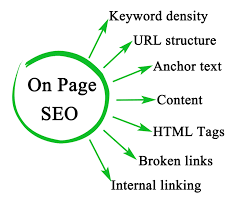Internal linking is a crucial on-page SEO strategy that enhances website navigation, user experience, and search engine rankings. When done correctly, internal links help distribute link equity across pages and establish a logical site structure.

Why is Internal Linking Important for SEO?
1. Enhances Website Navigation
Internal links help users seamlessly move between related content, improving engagement and reducing bounce rates. A well-structured internal linking strategy guides visitors to relevant pages, making navigation smooth.
2. Distributes Page Authority (Link Juice)
Search engines like Google use internal links to understand the importance of pages. Linking from high-authority pages to new or less-ranked pages helps distribute link equity, boosting their ranking potential.
✅ Example: Linking from a high-performing SEO blog to a newly published article on Content Writing improves its visibility.
3. Improves Indexing & Crawling
Search engine crawlers rely on internal links to discover and index pages. A well-linked site ensures that all pages are accessible, preventing orphan pages from being ignored.
✅ Tip: Use a sitemap and structured internal links to assist Google in indexing all content efficiently.
4. Boosts User Engagement & Dwell Time
Relevant internal links encourage users to explore more content, increasing dwell time. The longer users stay on your site, the better your SEO performance.
✅ Example: Linking a blog on SEO Strategies to a related post on Local SEO keeps visitors engaged longer.

Best Practices for Effective Internal Linking
1. Use Descriptive Anchor Text
Instead of using generic terms like “click here,” use keyword-rich anchor text that clearly describes the linked page.
✅ Example: Instead of “Learn more here,” use “Check out our guide on Website Development.”
2. Link to High-Value & Relevant Pages
Prioritize linking to high-value pages like service pages, cornerstone content, and high-performing blogs.
3. Maintain a Natural Link Structure
Avoid overloading pages with excessive internal links. A logical linking pattern keeps the user experience intuitive.
4. Use a Mix of Deep & Surface-Level Links
Link to a mix of homepage, category pages, and deep content to ensure a well-balanced internal linking structure.
✅ Example: A blog on Paid Ads can internally link to a service page and another detailed SEO guide.
5. Avoid Keyword Stuffing in Anchor Texts
Overloading internal links with exact-match keywords can appear spammy. Use a variety of natural, contextual anchor texts.
6. Ensure Links Open in the Same Tab
Unlike external links, internal links should open in the same tab to maintain user experience and engagement.
7. Regularly Audit & Update Internal Links
As content grows, revisit and update old posts with new relevant internal links to keep your SEO strategy fresh.
Final Thoughts: Maximize Your SEO Potential
An effective internal linking strategy not only boosts your SEO rankings but also enhances user experience and engagement. By implementing these best practices, you can improve site structure, search visibility, and conversion rates.
Need Help with SEO?
At Social Media Max, we specialize in optimizing websites for better search rankings. Contact us today at 0161 399 3517 or email Syed_66@hotmail.com to enhance your SEO strategy!